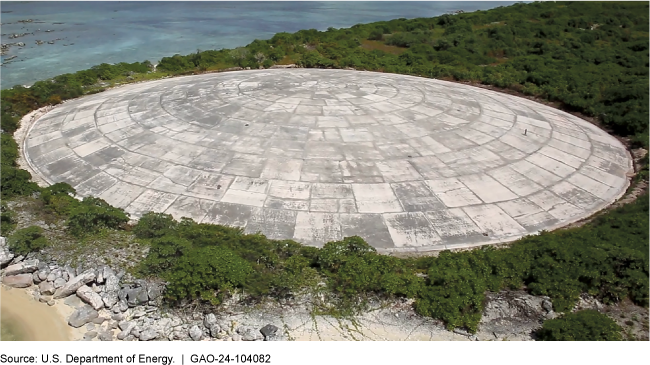Nuclear Waste: Changing Conditions May Affect Future Management of Contamination Deposited Abroad During U.S. Cold War Activities
Fast Facts
U.S. Cold War activities caused radioactive contamination in three other countries.
The contamination in Greenland—from a closed nuclear reactor—and in Spain—from an aircraft accident—is being monitored. But changing climate and economic conditions have raised concerns about future effects on local areas.
In the Marshall Islands—where the U.S. tested nuclear weapons—local officials are worried that rising sea levels may impact contaminated sites. The Department of Energy believes the health risk is low but has struggled to explain this to the community. We recommended DOE develop a communication strategy on the contamination for the islands.
The U.S. built Runit Dome in the 1970s to contain radioactive debris in the Marshall Islands

Highlights
What GAO Found
U.S. Cold War activities resulted in radioactive contamination in three locations: Greenland (part of the Kingdom of Denmark), Spain, and the Republic of the Marshall Islands (RMI) (see fig.). In Greenland, radioactive liquid—generated by a small nuclear reactor that powered the U.S. Camp Century base—remains entombed under ice. In Spain, a mid-air collision resulted in radioactive contamination around Palomares. The United States and Spain cleaned up much of the radioactive material and have monitored the remaining material since. In RMI, contamination from nuclear weapons tests and the resulting fallout remains measurable on several atolls, some of which are still uninhabitable.
Figure: Locations of Radioactive Contamination from U.S. Cold War Activities Abroad

Conditions have changed in all three locations since the original contamination. Most affected are the environment and inhabitants of RMI, where the Department of Energy (DOE) has ongoing responsibilities. Specifically:
- Greenland. At Camp Century, Denmark instituted permanent ice sheet monitoring to address concerns that climate change could release contamination. However, a 2021 study reported that contamination likely would remain immobile through 2100.
- Spain. In Palomares, Spanish officials reevaluated the radioactive contamination in the 1990s and found it exceeded European Union standards. In 2015, U.S. and Spanish authorities signed a statement of intent to further remediate Palomares but have not reached a final agreement.
- RMI. In RMI, people are concerned that climate change could mobilize radiological contamination, posing risks to fresh water and food sources. DOE assesses human radiation exposure and monitors environmental contamination in RMI. DOE considers human health risk to be low, but RMI officials believe DOE has downplayed the risk. This and other disagreements fuel distrust of DOE's information. By implementing a sustainable communication strategy in RMI, DOE could improve the Marshallese people's access to, and trust in, information on contamination as environmental conditions change.
Why GAO Did This Study
The United States conducted defense activities in many countries during the Cold War. These activities resulted in radioactive contamination in three countries: Greenland, Spain, and RMI. During the 1960s, the United States buried radioactive liquid in Greenland's ice while operating the experimental Camp Century base to study the feasibility of installing nuclear missiles there. In 1966, in Spain, two U.S. defense aircraft collided, dispersing radioactive debris over the town of Palomares. From 1946 to 1958, the United States conducted 67 nuclear weapons tests in RMI, and the resulting radioactive fallout contaminated several atolls.
This report examines (1) the amount and type of radioactive contamination in Greenland, Spain, and RMI; and (2) how conditions have changed at these sites, and the extent to which the environment and inhabitants have been affected by these changed conditions. GAO reviewed key literature on the contamination and interviewed U.S. and foreign government officials.
Recommendations
The Secretary of Energy, as a part of the agency's ongoing efforts to address the legacy of U.S. nuclear testing in RMI, should develop and document a strategy for communications on radioactive contamination that is sustained, understandable, transparent, engages the RMI government, and builds on lessons learned. DOE concurred with GAO's recommendation.
Recommendations for Executive Action
| Agency Affected | Recommendation | Status |
|---|---|---|
| Department of Energy | The Secretary of Energy, as a part of the agency's ongoing efforts to address the legacy of U.S. nuclear testing in the Republic of the Marshall Islands, should develop and document a strategy for communications on radioactive contamination that is sustained, understandable, and transparent; engages the RMI government; and builds on lessons learned. (Recommendation 1) |
In June 2024, DOE officials told us that over the past three years, DOE has made substantial efforts to improve engagement with Republic of the Marshall Islands (RMI) officials and stakeholders including by establishing regular meetings with multiple RMI government agencies to promote collection and consideration of feedback on current and future DOE supported projects. DOE plans to continue to expand these efforts by working with RMI officials to define their specific needs. In addition, DOE plans to participate in an interagency working group that includes DOE and multiple RMI agencies where DOE can actively engage with the RMI to understand specific challenges and develop effective solutions. DOE officials also stated that they expect to develop and implement in collaboration with the RMI a plan to communicate on radioactive contamination that is sustained, understandable, and transparent. Further, DOE intends to consult with the U.S. State Department as the plan is developed and implemented to ensure alignment with U.S. priorities and commitments. According to DOE officials, the plan would be reviewed and updated as needed to ensure that it evolves with stakeholder needs. GAO will continue to monitor implementation of this recommendation. By implementing a sustainable communication strategy in RMI, DOE could improve the Marshallese people's access to, and trust in, information on contamination as environmental conditions change.
|
